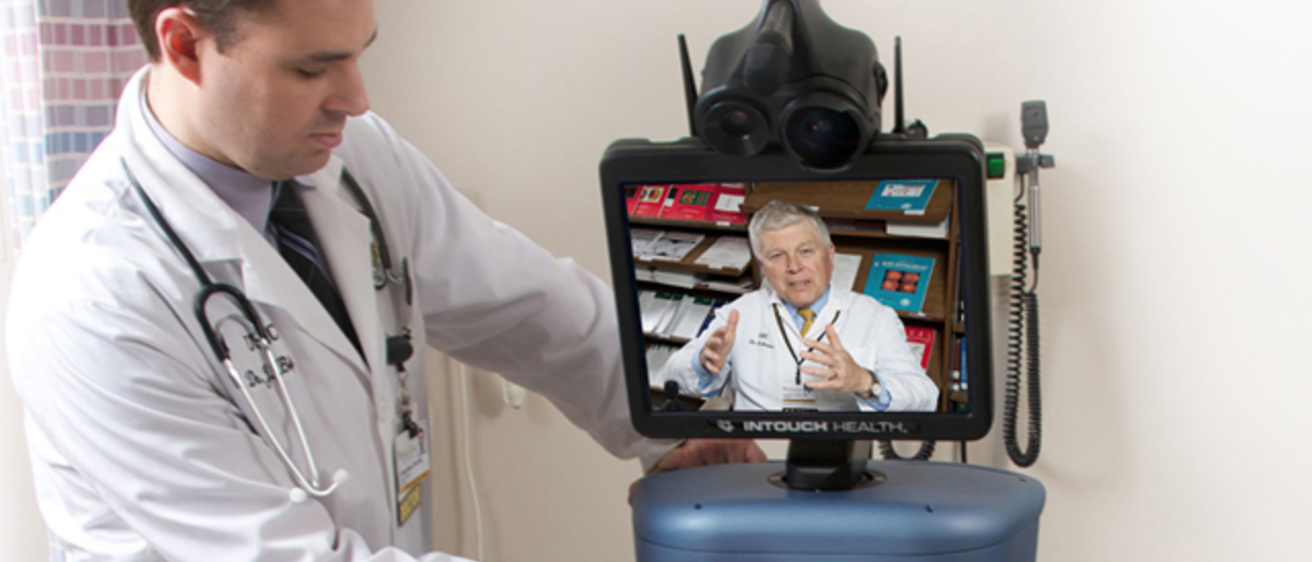During a stroke, which occurs when the blood supply to the brain is interrupted by a blood clot or hemorrhage, every second matters. A partnership between Mercy Medical Center in Clinton, Iowa, and University of Iowa Hospitals and Clinics in Iowa City will bring vascular neurology experts to a patient’s bedside during those first critical minutes.
With the aid of a wireless remote presence robot, patients at the Mercy-Clinton emergency room now have immediate access to specialists from the University of Iowa Stroke Center, a nationally certified primary stroke center, which gives patients the most advanced stroke care available. The robot, the first of its kind in the state of Iowa, connects stroke patients for a consultation and neurologic examination within minutes.
For Gerri Nichols, the availability of the stroke robot likely made a difference in her recovery after experiencing a stroke on the morning of May 20. As she and her husband, Highland, prepared to leave for church, Gerri suddenly didn’t feel well and her slurred speech alerted Highland to the fact that she may be having a stroke.
Arriving just minutes later to the Mercy-Clinton emergency room, the robot manned by UI neurology specialist Enrique Leira, M.D., was immediately in the room to begin the critical assessment. Determining Gerri’s serious condition, she was airlifted to UI Hospitals and Clinics for a specialized procedure to remove the clot. Within four and a half hours of the first symptoms, Gerri was out of surgery and recovering.
Transferred back for rehabilitation at Mercy-Clinton’s Inpatient Therapy Center at the South Campus, Gerri was able to return home June 6, just 17 days from the onset of a life-threatening stroke.
"They felt that she would be able to have a complete recovery," Highland says, expressing his gratitude for the availability of this technology and the international experts accessible in Clinton and minutes away from their home.
"The ability for Mercy to connect quickly to the advanced and specialized care provided by the University of Iowa stroke team further enhances the quality of the care that we can give to the people in Clinton and the surrounding area,” says Sean Williams, president and CEO of Mercy Medical Center. "It brings a world-class provider into our organization and it is very exciting to be a part of this expanded level of care."
Accurate diagnosis of a stroke and timely treatment is paramount to improved patient outcomes, but rural communities in Iowa often lack the neurology coverage in the emergency room to facilitate management of acute stroke, says Harold Adams, M.D., UI professor of neurology and director of the UI Stroke Center.
"The stroke robot allows us to conduct a full diagnostic exam on the patient and gather all the clinical information we need to more accurately advise our emergency room colleagues in rural emergency room settings and to provide excellent care for the patient," Adams says.
Although separated by distance, a UI neurology specialist controls the wireless robot and communicates with the patient and the Mercy health care team through the use of two-way video conferencing. Neurologists can gather information about symptoms, including whether the patient can perform a series of physical movements and responses. With the robot’s advanced monitors, cameras, and microphones, the patient can speak directly to the physician as if he or she were in the room.
After the telehealth stroke consultation, the UI physician and Mercy’s Emergency Department physician discuss the recommended treatment. If symptoms indicate that the patient is having a stroke, a clot busting medication, called t-PA, can be given within three to four and a half hours from the beginning of stroke symptoms. Other options may include transferring the patient to UI Hospitals and Clinics for surgery or advanced care.
The ability to access the UI team at Mercy-Clinton is due in part to recent advancements in health technology. Electronic medical records, digital CT images, and the ability to communicate immediately through Internet capabilities and the wireless mobile robot provide access that a few years ago would not have been possible. The robot, available from InTouch, is being used across the United States to provide remote access to physician care.
